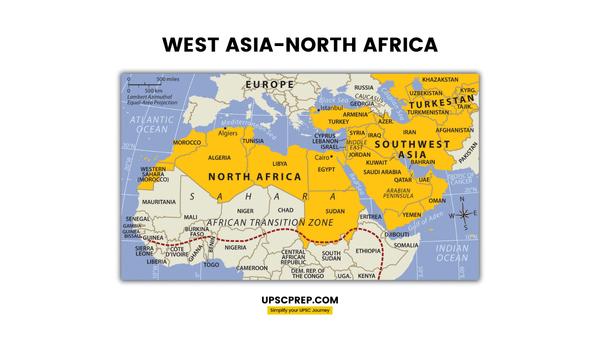Table of contents
What is WANA?
The West Asia-North Africa (WANA) region is a geopolitical and cultural area that encompasses countries in the western part of Asia and the northern part of Africa. This region is often referred to in discussions of international relations, economics, and cultural studies due to its strategic importance, rich history, and diverse cultures.

Geographical Scope:
- West Asia:
- Countries: Includes countries like Saudi Arabia, Iran, Iraq, Israel, Jordan, Lebanon, Syria, Turkey, Yemen, Oman, United Arab Emirates, Qatar, Bahrain, and Kuwait.
- Features: This sub-region is characterized by its arid climate, vast deserts, and significant oil reserves. It is also home to several ancient civilizations and religious sites.
- North Africa:
- Countries: Includes countries like Egypt, Libya, Tunisia, Algeria, Morocco, and Sudan.
- Features: This sub-region is known for its Mediterranean coastline, the Sahara Desert, and the Nile River. It has a rich history with ancient civilizations such as the Egyptians and Carthaginians.
Historical Significance
- Cradle of Civilizations: The WANA region is home to some of the world’s oldest civilizations, including Mesopotamia, Ancient Egypt, and the Persian Empire.
- Religious Importance: It is the birthplace of major world religions such as Islam, Christianity, and Judaism.
Cultural Diversity
- Languages: Arabic is the predominant language, but Persian, Turkish, Hebrew, and various Berber languages are also spoken.
- Ethnic Groups: The region is ethnically diverse, with Arabs, Persians, Turks, Kurds, Berbers, and others.

What are the major geopolitical challenges facing the WANA region?
The West Asia-North Africa (WANA) region faces a multitude of geopolitical challenges that have significant implications for regional and global stability. Here are the major geopolitical challenges:
Ongoing Conflicts and Civil Wars


- Syrian Civil War: Since 2011, Syria has been embroiled in a devastating civil war involving multiple factions, including the Syrian government, opposition groups, ISIS, and Kurdish forces. The conflict has resulted in massive loss of life, displacement, and regional instability.
- Yemen Conflict: The war in Yemen, primarily between the Houthi rebels and the Saudi-led coalition, has led to one of the world's worst humanitarian crises, with widespread famine, disease, and displacement.
- Libyan Civil War: Libya remains divided between rival factions in the east and west, leading to ongoing violence and instability since the fall of Muammar Gaddafi in 2011.
Israeli-Palestinian Conflict


- Territorial Disputes: The long-standing conflict between Israel and Palestine over land, sovereignty, and the status of Jerusalem remains unresolved, leading to periodic violence and international diplomatic challenges.
- Peace Process Stalemate: Efforts to achieve a two-state solution have repeatedly stalled, contributing to ongoing tensions and instability in the region.
Sectarian Tensions

- Sunni-Shia Divide: The rivalry between Sunni-majority Saudi Arabia and Shia-majority Iran exacerbates sectarian tensions across the region, influencing conflicts in Syria, Yemen, Iraq, and Lebanon.
- Proxy Wars: Both Saudi Arabia and Iran support various proxy groups in regional conflicts, further destabilizing the area.
Terrorism and Extremism
- ISIS and Al-Qaeda: Despite territorial losses, extremist groups like ISIS and Al-Qaeda continue to pose significant security threats through insurgency, terrorism, and radicalization.
- Local Affiliates: These groups have local affiliates in countries like Yemen, Libya, and Egypt, contributing to regional instability.
Political Instability and Governance Issues
- Authoritarian Regimes: Many countries in the region are governed by authoritarian regimes with limited political freedoms, leading to public discontent and periodic uprisings.
- Failed States: Countries like Syria, Yemen, and Libya are considered failed states with weak central governments, making them breeding grounds for conflict and extremism.
Economic Challenges

- Oil Dependency: Many WANA economies are heavily dependent on oil exports, making them vulnerable to fluctuations in global oil prices. Economic diversification remains a significant challenge.
- Youth Unemployment: High rates of youth unemployment and underemployment contribute to social unrest and migration pressures.
Foreign Interventions and Influence

- U.S. and Russia: Both the United States and Russia have significant military and political interests in the region, often supporting opposing sides in conflicts, such as in Syria.
- Turkey and Gulf States: Regional powers like Turkey, Saudi Arabia, and the UAE also exert influence through military interventions and support for various factions.
- The growing influence of China.
Refugee and Migration Crisis
- Displacement: Conflicts in Syria, Yemen, and other countries have led to large-scale displacement, creating refugee crises that strain neighboring countries and Europe.
- Humanitarian Impact: The influx of refugees has significant humanitarian, economic, and social impacts on host countries.
Water Scarcity and Environmental Issues
- Water Resources: The region faces severe water scarcity, exacerbated by climate change, population growth, and mismanagement of resources.
- Environmental Degradation: Desertification, pollution, and over-extraction of resources contribute to environmental challenges that can fuel conflicts over scarce resources.
Regional Rivalries and Alliances
- Gulf Cooperation Council (GCC) Rift: The diplomatic rift within the GCC, particularly the blockade of Qatar by Saudi Arabia, UAE, Bahrain, and Egypt, has strained regional alliances.
- Normalization with Israel: Recent normalization agreements between Israel and some Arab states (e.g., UAE, Bahrain) have shifted regional dynamics, creating new alliances and tensions.
Conclusion:
The WANA region's geopolitical landscape is highly complex, with interwoven challenges that require multifaceted and coordinated approaches for resolution. Addressing these issues is crucial for regional stability and global security.
Try to answer:
How do the geopolitical challenges in the WANA region impact India's interests?

Write UnLimited Course (1 Year)
Write answers from any source, we will evaluate them for you.
